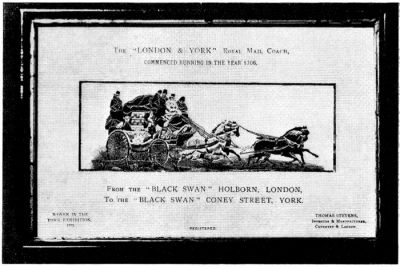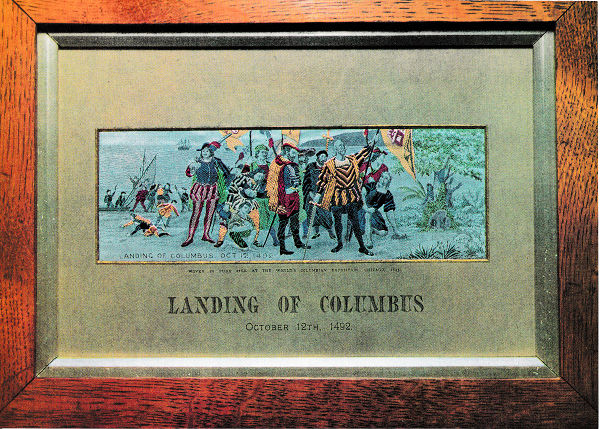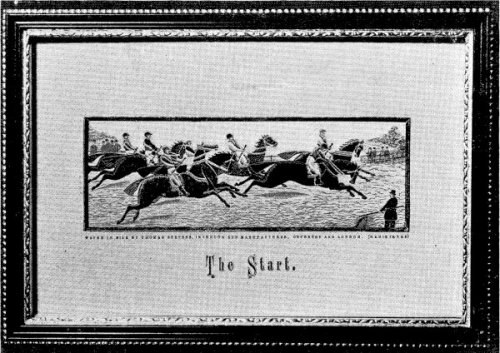
www.Stevengraph-Silks.com
|
|
|
|
|
|
| |
|
|
|
|
|
by Austin Sprake
|
|
 Stevens silk picture woven in ten colours at the York Exhibition of 1879
Stevens silk picture woven in ten colours at the York Exhibition of 1879
|
P i c t u r e s S t e v e n s W o v e
|
THE weaving of fancy silk ribbons began in
Coventry around 1700 and almost came
to an abrupt end in 1860 when the industry
suffered a disastrous slump as a result of the
Government removing the prohibition on imported
silk goods. Cheap foreign wares flooded into
England, and most of the Coventry weavers were
forced out of business.
Thomas Stevens had already been working in the
silk weaving trade all his life and in 1854 had set
up his own business. He was experimenting with
new ideas and improved techniques before the
slump, and when this came he accepted the chal-
lenge it presented. He succeeded in adapting the
Jacquard loom to produce small multi-coloured
silk pictures of infinite variety, and in 1863, when
most other Coventry weavers had packed up, he
sold his firt silk woven bookmarkers. These were
an immediate success and soon afterwards he
developed the idea of selling similar things made
up in the form of Christmas and birthday greeting
cards, Valentine cards, calendars, sashes and
badges.
In no time Stevens had created for himself an
entirely new market, with sales through booksellers
and stationers, as opposed to selling to the drapery
trade, for which market all Coventry brocades and
ribbons had previously been produced. The book-
markers depicted contemporary scenes, portraits of
royalty and notables, illuminated texts from the
Bible, poems, seasonal and birthday greetings.
In 1879 Stevens produced his little pictures in
yet another form. He fitted them into simple card-
board mounts all ready for framing and hanging in
the home. The striking three-dimentional effect of
these mounted silk pictures helped to give instant
|
|
success, and over the ensuing thirty years thousands
upon thousands were sold. Stevens died in 1888
in London, from where he had been directing the
business for several years, while his two sons ran
the factory in Coventry. The business remained in
family hands for another twenty years until it was
made a limited company in 1908. About this time
a number of the silk pictures were produced in
miniature form and sold as postcards. Although
few of these bore his name, they can be identified
as his quite easily owing to being so similar to his
mounted pictures.
As 1914 approached and fashions changed, the
demand for bookmarkers, silk pictures and fancy
novelties dwindled, and although the factory
remained in business producing other silk articles
until it was totally destroyed in the Coventry blitz
of 1940 only a very few silk pictures were made in
the 'twenties and 'thirties. The portraits of King
George VI and Queen Elizabeth (the Queen Mother)
made in 1938, some in the form of calendars, were
probably the last silk pictures ever produced at the
factory.
Stevens set up portable looms at many of the
large trade exhibitions in Britain, on the Continent
and in America, and visitors were able to watch the
pictures being woven and were invited to make
purchases then and there. The first place at which
Stevens exhibited looms weaving pictures, which
were actually mounted and sold on the spot, was
the York Exhibition of 1879. The label stuck to the
back of the mount of the London and York coach
states: "This Loom exhibited by Thomas Stevens
(in the Machinery Department York Exhibition
1879)is now weaving this pattern in silk, illuminated
in ten colours. This loom contains 160 shuttles, the
|
 Stevengraph of the Landing of Columbus
Stevengraph of the Landing of Columbus
woven at the Chicago Exposition of 1893
|

|
The Start, one of the four
horse racing pictures that
were among the most
popular that Stevens
produced
|
|
largest number in any loom in the world, and has
taken highest prize medals at all exhibitions."
Pictures woven at these exhibitions usually have
the fact printed on the front of the mount, which
is a great help for dating purposes. "The Landing
of Columbus" was woven in the Chicago Exposition
of 1893; the pictures "Columbus leaving Spain"
and "The Signing of the Declaration of Independ-
ence" are also found with the same Chicago
Exposition title. A large number of pictures of all
subjects were exported to America by Stevens,
which accounts for their popularity amongst
American collectors today.
Some indication of the order in which the
various titles were produced can be obtained from
their position on the list of titles found on the
trade label stuck to the back of most of the pictures.
Later versions of some pictures and portraits never
possessed a label. A diamond shaped registration
mark is found on the label of early examples, while
a similarly shaped mark is impressed on the front
of the mount of some pictures. Both marks were
discontinued soon after 1879.
The style of the lettering of the title printed on
the front of the mount can be a rough guide to age.
The early style was that used on "The First Touch";
a later style appears on "The Landing of
Columbus". That on "Peeping Tom" is much
later. It must have been produced after 1908 when
the firm became a limited company. It must be
emphasised that these rough dating clues only
indicate when the picture was mounted and sold,
not necessarily when it was woven, because the
pictures were woven in long rolls or bolts, some of
which were immediately cut up and mounted for
selling while the remaining bolts were put into store
for future use.
There are about 175 subjects in mounted silk
pictures. Colour variations exist on many of them,
but care should be taken not to mistake a simple
case of fading for a major colour variation. Greens,
|
|
pinks and yellows seem especially vulnerable, and
exposure to direct sunlight will soon affect these
colours. One example of a true colour variation is
the penny farthing race, entitled "The Last Lap".
On some versions, the axles, shafts and saddles are
black, while on others these are in golden-yellow.
The mounted pictures cover all manner of sub-
jects, and cater for all tastes. Those collectors who
dislike blood sports will not seek the fox hunting
set, "The Meet", "Full Cry" and "The Death",
nor the coursing trio, "The Slip", "The First
Point" with the greyhound handler missing, and
the same title with the man woven in, while they
will certainly avoid the colourful "Spanish Bullfight"
picture depicting a black bull being baited by gaily
dressed matadors and a picador, watched by a
packed arena. Pictures such as the delightful games
set, "The First Touch", "The First Set", "The
First Over" and "The First Innings" will, however,
appeal to everyone.
The four horse racing pictures, "The Start",
"The Water Jump", "The Struggle" and "The
Finish" are amongst those most commonly seen
today, which indicates that they were very popular
when made and sold in vast numbers. The much
larger racing picture entitled "Iroquois, winner of
the Derby 1881, ridden by F. Archer" was ap-
parently woven as a tobacco advertisement, and is
now quite scarce.
Stevens could not ignore Lady Godiva's associa-
tion with his native city, and there are three
mounted pictures connected with her exploit, "The
Lady Godiva Procession", "Ye Lady Godiva" and
"Peeping Tom".
The development in methods of transport is
presented in elaborate detail, starting with "The
Good Old Days", a colourful stage coach scene, a
scarcer later version of which is found with a
pleasant rural landscape. Then there is "The First
Train" under which title is the wording "built by
Geo. Stephenson in 1825". Next, we have pro-
|
gressively more modern versions of the steam train.
No Stevens picture is known to exist with a motor-
car as its subject, but a later version of "The Last
Lap" shows a bicycle race, as opposed to the penny
farthing race. The Oxford and Cambridge boat race
pair "Are You Ready" and "The Final Spurt"
must have adorned the walls of many a schoolboy's
study at the turn of the century.
Famous historical events were recorded in great
detail, with "The Death of Nelson" and "Wellington
and Blucher meeting after the Battle of Waterloo"
being those in this category which are most com-
monly come across today. Pictures of well-known
landmarks and famous places were also woven.
Kenilworth Castle and the Grey Friar's Green at
Coventry are quite amazing for the detail when
examined closely. These two larger sized black and
white pictures lack the colour of Stevens' smaller
pictures, but any representative collection could not
be without two such superbly woven examples in
the original mounts with Stevens titling.
The portrait pictures provide further scope for
collectors. The portrait of Gladstone may appear
rather sombre, but it exists in six version, and a
present day photograph could hardly reproduce
the facial features, the wrinkles and whiskers with
greater accuracy. Some of the portraits of royalty
and notables, and of famous jockeys in their dif-
ferent owners' racing colours will add brightness to
any collection, but the full length studies of the
boxers Jem Smith, John Sullivan, Jake Kilrain and
Charlie Mitchell are all rather drab as they possess
little color.
The growing popularity of these Victorian
novelties with collectors nearly a century afterwards
could hardly have been foreseen by Stevens in 1879.
Although the mounts can become very brittle, the
pictures are nevertheless far more conveniently
handled than many collectors' items, which enables
collectors to swap their duplicates very easily. They
should however be carefully handled, preferably
|
|
Stevengraph in memory of Fred Archer,
the famous jockey
framed, and definitely kept away from a damp wall and out of direct sunlight.
Beauty lies in the eyes of the beholder, and these
little pictures woven with such amazing three-
dimensional effect do not appeal to everyone, but a
collection of them will give cheer to an empty wall,
pleasure to a receptive eye, and will provide the
diligent searcher with something fresh to look for
and with a very sound investment.
|
|
|
The First Touch, showing
the early style of lettering
used by Stevens for the
title on the front of
the mount
|
|
|